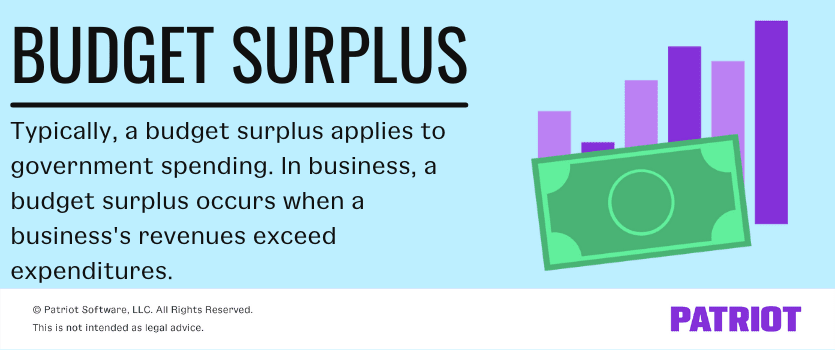If you have more money at the end of the year than you expected, you might think you have a budget surplus. But, is that what a budget surplus actually is? Keep reading to find out what is a budget surplus, the budget surplus definition, and more.
What is a budget surplus?
Generally, a budget surplus applies to governments and the government’s spending while running a locality, state, or country. For example, the USA last had a budget surplus during the fiscal year 2001. So, what is the surplus budget meaning?
A budget surplus (aka fiscal surplus) occurs when revenue exceeds spending for a set period. For governments, this means that the government brought in more money than it spent. But, how does a budget surplus apply to businesses?
In business, a budget surplus is commonly known simply as a surplus. Like a budget surplus, a business surplus occurs when the company earns more than it spends during a set period (e.g., a fiscal year). Basically, the surplus is what is left over after a business pays all expenses (i.e., when revenues exceed expenditures).
Business budget surpluses are also known as free cash flow or profits. And, individuals may refer to a surplus budget as net savings.

Budget surplus vs. budget deficit
The opposite of a budget surplus is a budget deficit. A budget deficit means that the business (or government) spent more money than it earned during the set period.
While a budget deficit is not necessarily bad for government spending, a deficit in a business’s budget may be cause for a budget overhaul for the next fiscal year. Spending more money than your business earns for too long can result in high debts and even business bankruptcy.
How to record a budget surplus in your books
A continual budget surplus is profit for your business. Record the profits (aka retained earnings) on your balance sheet. Record the retained earnings from a budget surplus on the balance sheet as equity.
The budget surplus funds are not assets, though you can turn funds from equity into assets through investing. You can also record the retained earnings on the statement of retained earnings.
Calculate the budget surplus at the end of the year after paying all expenses and recording all revenue.
Examples of surplus
A budget surplus for business can result from different factors. So, let’s take a look at some examples of what can cause a surplus in your books.
Example 1
Your business budget was $15,000 for the year before. And, your revenue and expenses both equaled $15,000, so you broke even. You spent as much money as your business made.
This year, you decrease your expenses by $3,000 by negotiating with vendors for better deals. So, you set a budget of $12,000. You also increased your free marketing strategies on social media and brought in $15,000 in revenue for the year. As a result, you now have a surplus of $3,000 ($15,000 – $12,000).
Example 2
Last year, you set aside an advertising budget of $5,000 to place ads in different newspapers, social media platforms, and the local radio station. Your total budget for the year was $25,000.
The local radio station typically costs $2,500 for a three-month advertising season. But as a first-time advertiser, the station offers you a deal and provides you with a $500 discount, so you spend $2,000 on your advertising instead of $2,500.
At the end of the year, you only spent $4,500 of your $5,000 advertising budget. So, your budget surplus is $500 ($5,000 – $4,500).
Example 3
You set a budget of $15,000 for the entire year and plan to use Vendor A for your supplies. So, you allocate $10,000 to the cost of supplies from Vendor A for the whole year. But halfway through the year, you switch to Vendor B.
You’ve already spent $5,000 of your $10,000 budget with Vendor A, but Vendor B offers your supplies for $2,000 cheaper than Vendor A. For the second half of the year, you reduce supply costs from $5,000 to $3,000. At the end of the year, you’ve spent $8,000 of the $10,000 supply budget, leaving you with a $2,000 surplus ($10,000 – $8,000).
Other types of surplus
A budget surplus is not the only type of surplus business owners see when running a business. Other types of surplus include:
- Inventory surplus
- Consumer surplus
- Producer surplus
Inventory surplus
A surplus of inventory means that the business has more inventory than it sells or can reasonably sell. A common example of inventory surplus is a product sitting on the shelves at a store, unpurchased.
Your business may also have unsold inventory in a warehouse that is not moving to stores due to low consumer demand.
If you have an inventory surplus, it may be time to evaluate the prices of your products or consider your marketing strategies. You might also consider improving your purchasing system for better inventory monitoring and management.
Consumer surplus
With a consumer surplus, the cost of a product or service is lower than the amount a consumer would willingly spend. In other words, the customer profits when they purchase a product or service for less than they were willing to spend on the goods.
For example, a customer is willing to pay $30 for the novelty T-shirts your business sells. But, you price the shirts at $10 apiece. The $20 difference between your price and the amount a customer is willing to pay represents the consumer surplus.
Producer surplus
On the flip side to consumer surplus is the producer surplus. With a producer surplus, you sell a product or service for more than the lowest price you are willing to sell for. In other words, the seller profits in a producer surplus because you sell the product for more than your minimum pricing.
For example, it costs you $8 to make your novelty T-shirts. The minimum price you would set is $10, but you decide to sell the T-shirts for $30. The producer surplus is the $20 difference between the price you sell the T-shirts for and the minimum price you would accept ($30 – $10).
What to do with a surplus
If your business experiences a surplus, what do you do with it? You might use the surplus to:
- Invest the funds
- Give bonuses to employees
- Turn the surplus back into the business (e.g., purchasing new equipment)
- Hire employees
…And more. Before you decide, carefully review and prioritize what your business needs. For example, your company may require new equipment, so it would be better to purchase it than give bonuses.
This is not intended as legal advice; for more information, please click here.



